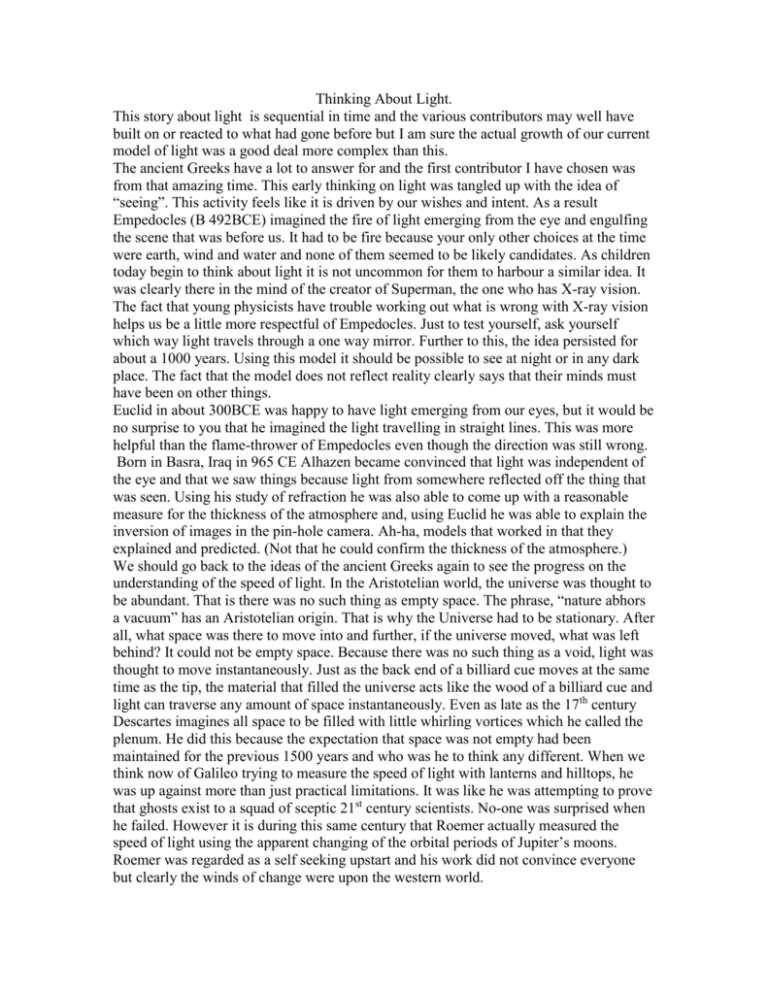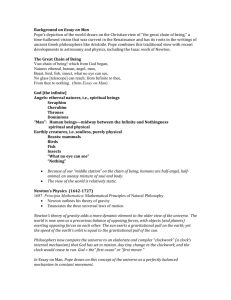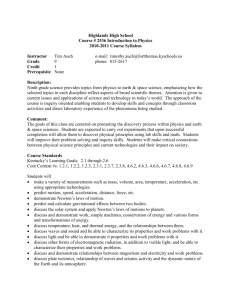Thinking About Light
advertisement

Thinking About Light. This story about light is sequential in time and the various contributors may well have built on or reacted to what had gone before but I am sure the actual growth of our current model of light was a good deal more complex than this. The ancient Greeks have a lot to answer for and the first contributor I have chosen was from that amazing time. This early thinking on light was tangled up with the idea of “seeing”. This activity feels like it is driven by our wishes and intent. As a result Empedocles (B 492BCE) imagined the fire of light emerging from the eye and engulfing the scene that was before us. It had to be fire because your only other choices at the time were earth, wind and water and none of them seemed to be likely candidates. As children today begin to think about light it is not uncommon for them to harbour a similar idea. It was clearly there in the mind of the creator of Superman, the one who has X-ray vision. The fact that young physicists have trouble working out what is wrong with X-ray vision helps us be a little more respectful of Empedocles. Just to test yourself, ask yourself which way light travels through a one way mirror. Further to this, the idea persisted for about a 1000 years. Using this model it should be possible to see at night or in any dark place. The fact that the model does not reflect reality clearly says that their minds must have been on other things. Euclid in about 300BCE was happy to have light emerging from our eyes, but it would be no surprise to you that he imagined the light travelling in straight lines. This was more helpful than the flame-thrower of Empedocles even though the direction was still wrong. Born in Basra, Iraq in 965 CE Alhazen became convinced that light was independent of the eye and that we saw things because light from somewhere reflected off the thing that was seen. Using his study of refraction he was also able to come up with a reasonable measure for the thickness of the atmosphere and, using Euclid he was able to explain the inversion of images in the pin-hole camera. Ah-ha, models that worked in that they explained and predicted. (Not that he could confirm the thickness of the atmosphere.) We should go back to the ideas of the ancient Greeks again to see the progress on the understanding of the speed of light. In the Aristotelian world, the universe was thought to be abundant. That is there was no such thing as empty space. The phrase, “nature abhors a vacuum” has an Aristotelian origin. That is why the Universe had to be stationary. After all, what space was there to move into and further, if the universe moved, what was left behind? It could not be empty space. Because there was no such thing as a void, light was thought to move instantaneously. Just as the back end of a billiard cue moves at the same time as the tip, the material that filled the universe acts like the wood of a billiard cue and light can traverse any amount of space instantaneously. Even as late as the 17th century Descartes imagines all space to be filled with little whirling vortices which he called the plenum. He did this because the expectation that space was not empty had been maintained for the previous 1500 years and who was he to think any different. When we think now of Galileo trying to measure the speed of light with lanterns and hilltops, he was up against more than just practical limitations. It was like he was attempting to prove that ghosts exist to a squad of sceptic 21st century scientists. No-one was surprised when he failed. However it is during this same century that Roemer actually measured the speed of light using the apparent changing of the orbital periods of Jupiter’s moons. Roemer was regarded as a self seeking upstart and his work did not convince everyone but clearly the winds of change were upon the western world. By the start of the 18th century Newton’s concept of the universe was the dominant one. The celestial bodies have broken free of the crystal spheres and plunge through empty space subject only to the force of gravity. Newton’s model for the universe is “Corpuscles, the void and action at a distance.” This has been an extraordinarily useful and long lived model. It has enabled us to imagine almost every system from the nucleus, through the atom, the solar system, the galaxy and indeed the universe. Particles, the void and action at a distance. Newton conquered England and France. Voltaire said, “We are all his disciples now.” This was the kingdom of the Enlightenment and Newton was sovereign. Light was a stream of particles. A prism separated the particles responsible for the different colours. Germany bypassed the Enlightenment and went straight to Romanticism. Goethe the writer was appalled by Newton’s ideas. He had a perfectly reasonable question. If everything is particles, the void and action at a distance, where was soul, beauty, joy, art and love? He spent years trying to come up with an alternative model for light. He committed the error of Empedocles by tangling light with the subjective act of seeing. His years of work on the book “The Theory of Colour”, which he regarded as his most important work was considered a waste of time. In fact, in the 20th Century Goethe’s work was resurrected and became important for Edwin Land in his development of the way the eye responded to colour. Goethe influenced writers and painters back in England. Turner produced a work entitled “Light and Colour (after Goethe): the morning after the deluge, Moses Writing the Book of Genesis.” This was decades after Newton died. While Newton was alive, the Dutchman Christian Huygens, very polite and respectful of Newton, thought that light might be better represented by wave motion. Newton, always tetchy and hypersensitive didn’t. He had his arguments. Diffraction was a problem. Whenever water waves or sound encounter an aperture they spread out after going through the aperture. Light was not observed to do this. Furthermore, waves require a medium. If there was a medium for light waves, why hadn’t the earth and all the planets slowed down as they ploughed through it? The wonderful thing about this interaction was that it was about the predictive value of a model. Huygens was not prepared to throw out the idea that the universe was abundant. The medium that filled Huygens universe was made of springy particles and he knew that in 1665 a Jesuit called Grimaldi had noticed that a shadow was smaller than it should be and that there were little fuzzy light and dark bits on the edge of the shadow. Newton’s reputation was so huge that he prevailed for the time being. By the start of the 19th century there was a mood building up against the machine like view of the universe that was the result of Newton’s creed. Romanticism was spreading though Europe and the poets and artists mentioned before were having an influence. As well as this, Newton was no longer around to tear strips off anyone who dared to disagree. Evidence that light was waves was accruing. In particular Thomas Young (D: 1829) had the temerity to demonstrate not just diffraction but also interference. So we entered the 19th century pretty sure that light was waves. But what in? What was the medium? There had to be an ether. This was the inheritor of Descartes’ plenum or even Aristotles’ conviction of the plenitude of nature. Even Maxwell, working with Faraday’s fields and who eventually nailed light as fluctuating electric and magnetic fields, spoke of the ether. “..there can be no doubt that the interplanetary and interstellar spaces are not empty, but are occupied by a material substance or body.” Maxwell’s four equations are the quintessence of modern scientific enterprise. They reveal that the Universe at bottom is mathematical, that it yields to observation and measurement and that the model makes predictions that can be confirmed. Radio and X-rays were soon to be discovered understood and employed. The formulation also made sense of Herschel’s discovery of infra-red radiation in the previous century. The story was not finished. In 1887 Michelson and Morley went in search of the ether and it simply wasn’t there to be found. This was one of the results that enabled Einstein to tie time and space, two totally disparate facts of our existence together as one. The thing that bound them together of course was the speed of light. So finding out about light, illuminated a good deal more than what anyone could have imagined. Of course there were more surprises to come. Max Planck found that the energy carried by light was directly proportional to the frequency of the light. He hated it because it meant that if you shone light of a given frequency on something the light had to be arriving in energy chunks equal to h. In anyone’s language, chunks were particles. Einstein again used what was thought to be an anomaly to explain the strange behaviour of the photo-electric effect. It was for this interpretation that he received his Nobel prize. So what was light, particles or waves? Light was neither and both, it was itself, but using the models to imagine its hidden behaviour we became more confident in our ability to predict what light would do. And what about space? Is it abundant or is it a Newtonian void? Most of us think of a vacuum and model space with the mathematical zero and we are inclined to be Newtonian in our thinking about the space between the nucleus and the electron shells and the space between the galaxies. This is a shame because although these regions are empty of matter they are chock full of properties. For a start they support the electric, magnetic and gravitational fields our other models depend on. When King Charles II gave the charter to the Royal Society in 1662, he was soon dismayed to hear that the scientists were bending their energies towards the weighing of air. Today our best brains are studying what most would describe as nothing at all, the nature of a vacuum. The study of light led to the study of space. This is unfinished business but I do think that I may live to see some as yet unimagined understanding. This piece derives almost totally from the compact but detailed “Light Years” by Brian Clegg, the encyclopedic “The Ascent of Science” by Brian L Silver and the absolutely wonderful “The Pearly Gates of Cyberspace” by Margaret Wertheim.





